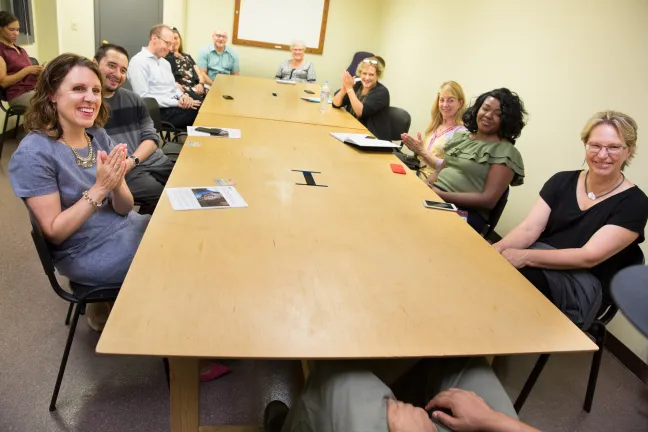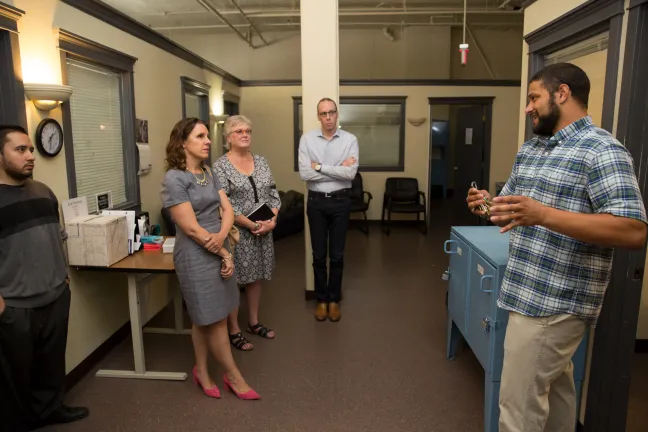“I’m bi-polar manic,” said George, a young man who chose not to share his last name, bluntly sharing his story in a room of a dozen people. “I was a social butterfly but a drinker, and I got involved with the wrong crowd. I was paranoid and in the state hospital and I was in {Multnomah County’s} Mental Health Court for five years.”
“My biggest problem was no housing when I got out,” he explains, “I was able to get housing and I did it all on my own, but I got arrested and placed in the state hospital again...”
“Everybody thought I was a hopeless cause. But I jumped in [to the Stabilization Treatment Preparation Program (STP)] and said whatever - I'm gonna show these guys.”
The “Stabilization for Treatment Preparation” Housing Program (STP) works like it sounds: It’s housing that provides psychiatric stabilization services, legal assistance, and a wide array of additional supports that help participants prepare for rejoining the community.
The 24-hour, 21-person dormitory style program serves men with behavioral health challenges who are involved with the criminal justice system. Participants come from the streets, jail, prison, state hospital or county crisis center, some of them struggling with severe addiction and mental illness.
“Here we have the services,” explained Jean Dentinger, Manager of Multnomah County Mental Health and Addiction Services Jail Diversion and Commitment Services programs. “STP provides community, personal support and addresses basic needs: Instead of spending limited resources in a motel where they are isolated.”
George graduated early from STP, was taken off probation early, and was accepted into Home Forward housing, said John Karp-Evans, Re-entry Program Operations Manager with Central City Concern, which helps staff and support the program. George also paid his restitution.
“What was it about the program here,” asked Multnomah County Chair Deborah Kafoury, who met with George recently while touring the Old Town-based program with county public safety leaders.
“They actually listened,” he replied. “I took my meds... I've got my chemistry back.”
Key to Success
STP is funded through a combination of county and state funds. Central City Concern (CCC) provides housing and support services. Multnomah County’s Department of Community Justice (DCJ), Mental Health and Addiction Services Division (MHASD), and county staff provide oversight and connections to support services such as counseling, transportation needs, job coaching etc.
In an industry that’s innately challenging and costly, proponents of the work say, STP has shown promising signs of success. More than 60 percent of men, who stay in the program for more than seven days, have successfully transitioned to housing or another level of care. Participants like George, they say, might not experience that level of success in more traditional programs.
“This little box was it,” said Karp-Evans, who pointed to a light blue locker box with individual lockers inside. “Having a medication locker, every client has a lock box. We track how many times it's opened. And we check on the keys.”
Every morning, a roster listing the number of times someone has accessed their box is recorded. The roster is shared with a contingent of support staff from parole officers, corrections counselors, case managers, to Forensic Diversion Linkage Coordinators, and Mental Health court staff, who help to intervene in a crisis and help clients meet their goals.
Participants are assessed over the duration of their stay. Some stay for fewer than seven days, others as long as six months. Those who stay longer than seven days are connected to the Oregon Health Plan. Staff works to fast-track clients’ needs for medication before a possible relapse can occur.
“We are able to inexpensively house participants because it’s not a healthcare facility,” explained Karp-Evans.
A safety net program
The dorm-style environment prevents isolation and encourages participants to interact with others. Walls inside the building don’t reach the ceilings, so staff can also hear developing problems they may not otherwise be able to see.
Case managers meet with clients at on-site offices to prevent missed appointments.
Participants work on life skills with set times for laundry, and designated refrigerator and pantry space.
There’s even have an Xbox, Karp-Evans shares with the group.
“It's a huge hit. Participants have to check it out,” said Karp-Evans. “They have to be in compliance obviously.”
The program aims to advance participants from shared transitional housing to supportive housing or permanent housing.
Participants are able to build rental history during their stay at STP and work on barriers that have prevented them in the past from gaining long term housing. Many clients have been able to pay off past landlord debts and restitution while in the program.
“Other facilities look very favorably at those who are released from here,” explained Dentinger. The program also works with housing agencies to provide eviction stabilization services, she said, so clients can come back to get stabilized and return to their housing without facing eviction.
“It's a fantastic safety net,” said Dentinger.
Participants are allowed three opportunities to change behavior or substance use violations before being discharged from the program. When a violation occurs a participant meets with staff to develop a remedy plan which can include support groups, daily check-ins and treatment classes.
“We've had several individuals who failed,” Karp-Evans said, but “then we work and work to figure out what failed and track what services were provided that worked. These changes are then put into motion by us for future individuals.”
The STP may also serve as a model for women involved in the criminal justice system, where gaps have been identified in transitional services.
"We had a woman who just came out of jail and we had no place to put her, " said Neal Rotman who manages the County’s Community Mental Health Program and was also on the tour. “ A women’s STP program is needed but funding remains difficult to secure at this time.”
“I got adopted by these people,” explains George to a smiling group. He now lives in permanent housing and continues to stay engaged in services that he was connected to while at STP.
“Our goal is to help them be self-sufficient,” Karp-Evans says. “We have different levels of care - so they can achieve stable daily living.”


